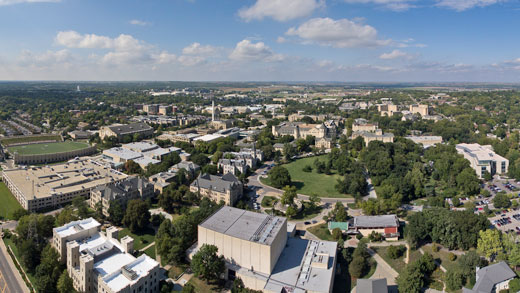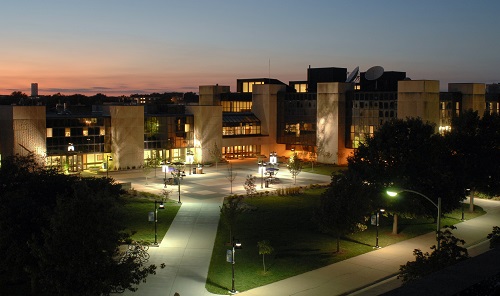05/02/18
K-State Current - May 2, 2018
K-State Current is a weekly news update for the Kansas Board of Regents to apprise the Regents on a few of the many successes and achievements made by K-State faculty, staff and students.
K-State News
University's Open/Alternative Textbook Initiative making education more affordable
College textbooks continue to take a bigger bite out of a student's higher education budget. According to the U.S. Bureau of Labor Statistics, based on 2017 data, textbook inflation has risen three times the rate of normal inflation, while The College Board finds that a full-time student at a public university shells out approximately $1,298 per year for books and supplies.
But an initiative at Kansas State University is turning the page on high textbook costs, saving the university's students more than $5.5 million since its launch in 2013.
"The Open/Alternative Textbook Initiative has benefited more than 38,000 Kansas State University students since its creation by offering affordable alternatives to expensive traditional textbooks," said April Mason, provost and senior vice president. "The initiative is projected to save 26,000 students an estimated $2.25 million in 2018."
The nationally recognized program was the brainchild of three Kansas State University professors. Beth Turtle, K-State Libraries professor; Andrew Bennett, professor and department head of mathematics; and Brian Lindshield, associate professor of food, nutrition, dietetics and health, were motivated to make high-quality education more affordable and to shift academic culture away from traditional textbooks to free online learning materials.
The program spends a little money in order to save a lot. Administered by K-State Libraries, the Open/Alternative Textbook Initiative provides financial incentives to instructors who convert their university courses from traditional textbooks to open/alternative textbooks. Kansas State University faculty can receive up to $5,000 for investing their time and research to make the switch. So far, more than 81 courses from 38 academic departments and units have been converted.
How does it work? As long as the students are not required to purchase any materials for the course, faculty who participate in the initiative have a great deal of flexibility with how they select, arrange and distribute their course content.
For example, a professor could use a textbook with an open copyright license written by another expert in the field, or they could create their own. The open copyright allows students to freely access and share the material. Faculty could also use library and university resources, such as scholarly journal articles, or create interactive online quizzes. Some use a combination of all of these.
Tiffany Bowers, a junior in cultural anthropology from Salina, has taken multiple classes that use open/alternative textbooks, including Introduction to Archeology with Lauren Ritterbush, associate professor of anthropology, and Introduction to Cultural Anthropology with Michael Wesch, associate professor of anthropology.
"They were both phenomenal classes, and it was an added plus that they incorporated incredibly useful, money-saving materials," Bowers said. "I think it is definitely the easiest way for students to interact with a textbook but not break the bank."
Private donors who recognize the impact of that investment contributed more than $100,000 toward the initiative in the 2017 fiscal year alone.
"Faculty who receive grants from the initiative to adapt open/alternative educational resources are saving their students money," said Rachel Miles, the K-State Libraries' partner in the initiative. "In addition, most of the converted courses maintain their open/alternative resources over the years, which demonstrates the sustainability of the program and student savings over the long term."
In the years since the financial incentives were established, open/alternative textbook team members have found even more innovative ways to enhance the program.
In 2015, the team worked with the Kansas State University Student Government Association to introduce an open/alternative textbook student fee. Now, university departments receive a $10 fee from students who take courses that utilize approved open/alternative materials. Nearly 90 percent of the fee supports the instructor's department, while a small percent is reinvested in the initiative. The fee entices departments to convert high-enrollment classes to open/alternative textbooks; it encourages faculty and departments to retain those less costly materials; and it provides stable funding for the Open/Alternative Textbook Initiative.
"This is the only textbook project we're aware of that receives direct financial support from students, thanks to the fee," Miles said. "The student government voted to enact that support, and its buy-in has attracted attention from K-State's administration, donors and other universities interested in starting their own programs."
The initiative team members also worked to implement an open/alternative textbook icon in the online university course catalog. The icon appears next to class listings that use an open or alternative text, alerting students that they won't need to buy expensive textbooks for those university offerings.
"The Open/Alternative Textbook Initiative has experienced explosive growth over the last five years," said Lori Goetsch, dean of K-State Libraries. "Now that its value has been recognized by outside donors, we hope to be able to find even more ways of reducing textbook costs and making university education more affordable."
K-State has been ranked among the best hospitality management programs in the country
Kansas State University has been ranked among the best hospitality management programs in the country.
The ranking from College Choice, a leading authority in college and university rankings and resources, put K-State in 22nd place for Best Master's in Hospitality Management. The full ranking is available online.
The hospitality management department is the only program that offers both undergraduate and graduate programs in hospitality management and the only program accredited by the Accreditation Commission for Programs in Hospitality Administration in Kansas. The program is recognized nationally and internationally for producing quality graduates who work around the world in the hospitality industry. In 2018, the department also was ranked No. 18 for Best Hospitality Management Degree programs by Best Value Schools and was ranked No. 32 for Best Hospitality and Leisure Management programs by the QS World University Rankings.
"We are so pleased that the quality of education in our master's program was recognized by College Choice," said Michael Ottenbacher, department head.
According to College Choice, the ranking is based on institutional reputation, graduation rates, selectivity and faculty resources. The data from their ranking comes from the National Center for Education Statistics' IPEDS database, U.S. News & World Report, Payscale and individual college websites.
College Choice noted that K-State's program "offers both comprehensive training and also highly specific preparation for students with particular interests in the industry. It is appropriate for both mid-career professionals seeking to improve their credentials and also recent graduates looking to build a competitive foundation for their career."
K-State Faculty Highlights
Diane L. Swanson, professor of management and Edgerley family chair in the College of Business Administration, is a distinguished visiting scholar for Benedictine University's doctoral program for senior executives in values-driven leadership.
In this capacity, Swanson will teach her course Leadership and Corporate Social Responsibility again on Benedictine University's campus near Chicago in May. Swanson designed this course to meet the needs of the senior executive students in this program, and she also serves on their dissertation committees.
Two of her books on executive leadership are used in this program: CSR Discovery Leadership, 2018, and Embedding CSR into Corporate Culture, 2014.
Swanson has held the position of distinguished visiting scholar at Benedictine University since October 2011, when she was selected by students as distinguished nationally in representing innovations in values-driven leadership.
Down to Earth: Kansas State University researcher part of $3.9 million NASA lava caves study
When lava flows down the slope of a volcano, it can leave behind an extreme environment ideal for unusual microbial life and potential clues to answering the life on Mars question.
Kansas State University geology professor Saugata Datta is one of the primary investigators of a new NASA study that will use a robotic vehicle to explore and collect data inside caves at Lava Beds National Monument in Northern California. The interiors of lava caves are home to bacterial films and coral-like mineral structures — called mineral biomarkers — that could help identify similar features that would provide evidence for extraterrestrial life on Mars or another planet.
"Humans have always had the idea that Mars has the progression of life," Datta said. "Studying delicate, extreme closed environments on Earth can give insight to the probabilities of finding more such features that relate to life and its presence on some extraterrestrial planetary surfaces."
The multi-institutional team of scientists and engineers recently received $3.9 million from NASA's Planetary Science and Technology for Analog Research program to support a three-year project in the lava caves. The team will use a four-wheeled rover, called CaveR, to explore the earthly lava caves and produce a detailed map of the inside of the caves. It will collect directed, high-magnification images to give the researchers information about the chemical makeup of the features on the cave walls.
"Lava tubes and collapsed lava structures are quite common on the surface of Mars," Datta said. "Orbiter missions currently observing the red planet can see them. A terrestrial cave on Earth can be explored and really studied to its extreme end to understand such a situation or environment that can form on the surface of Mars."
According to Datta, the earthly lava caves are home to microbial life that thrive in the dark and interact with water dripping from the cave ceiling and seeping through cracks in the walls. By understanding Earth's caves, researchers can create preliminary findings to better detect any possible Marian biosignatures — evidence of past or present life — that may have been preserved in Mars' lava caves, which are better protected from the elements than areas on the surface.
"Caves could be the best place to look for evidence of life on Mars since they offer shelter from extreme surface conditions and have a relatively constant climate over geologic time," said Jennifer Blank, principal investigator of the project at NASA's Ames Research Center. "By understanding how evidence of microbial life is preserved in Earth's caves — specifically in these biomineral features that will last long after the microbes that helped make them are gone — scientists can be better prepared to detect possible Marian biosignatures that may have been preserved in Martian lava caves."
Datta's research will focus on the water, rock and soil chemistry in the caves and what it looks like from the rover's perspective when these three elements interact with each other to create biomass — living or once living material.
"Our intergraded approach will give us a big picture of the ecosystem of the cave," Datta said. "It will give us an idea of the type of microbial community that can live in a system with a certain temperature and moisture. There are so many extreme environments where microbial communities can occur. This is what we are targeting because Mars is an extreme environment."
Along with Blank and Datta, other co-investigators include Anthony Colaprete, Ted Roush and Carol Stoker from the Planetary Systems Branch at NASA's Ames Research Center; machine vision specialists Uland Wong and Ara Nefian, and robotics engineers Arno Rogg and Antoine Tardy from the Intelligent Robotics Group at the Ames Research Center; electrical engineers Bruce White and Steve Battazzo from the flight instrument electronics division at the Ames Research Center; Diana Northup and Jenny Hathaway from the University of New Mexico; Magadelena Osburn from Northwestern University; and Duane Moser from the Desert Research Institute.
K-State Student News
Architectural engineering students awarded Lighting Education Scholarships
Seven Kansas State University architectural engineering students — Jose Ramos-Hernandez, Daniel Traknyak, Trevyn Sell, Katherine Clark, Jessica Woody, Anna Zuercher and Kathleen Walker — have been awarded a total of $14,000 in undergraduate scholarships for 2018-2019 from the Besal Lighting Education Fund.
Nationally, the Besal Fund awarded a total of 15 undergraduate and graduate scholarships for the upcoming school year to deserving students with an interest in lighting design and the lighting industry.
Fred Hasler, associate professor of architectural engineering and construction science, is the K-State Besal Fund liaison and supervises lighting-related courses in the department.
Scholarships for undergraduate and graduate students through the Besal Fund are available only to those attending a qualified Besal institution. Kansas State University, through its GE Johnson Architectural Engineering and Construction Science Department, is one of only seven universities in the U.S. eligible, due to its extensive offering of coursework related to lighting and lighting systems design. The other qualified schools include the University of Nebraska, Omaha; University of Nebraska, Lincoln; University of Colorado at Boulder; Penn State University; Rensselaer Polytechnic Institute; and the University of Kansas.
The fund was established in the honor of the late Robert J. Besal, whose career of more than 30 years in the lighting industry exemplified the high standards of knowledge, professionalism and service the Besal Fund aspires to encourage in today's students. It was created to provide a continuing program to improve lighting education in illuminating engineering and to find and recognize top lighting students and encourage their pursuit of lighting industry careers.
The Besal Fund is made possible by contributions from Acuity Brands Lighting Inc., its sales representatives and employees. Since the inception of the fund, more than $600,000 in scholarships have been awarded.
Anthropology student receives national award for GIS modeling of ancestral burial mounds
Jakob Hanschu, junior in anthropology and geography, Hillsboro, is the 2018 recipient of the Society for American Archaeology/Institute for Field Research Undergraduate Student Poster Award for his independent research poster, "Quantifying the Qualitative: Locating Burial Mounds in North-Central Kansas."
Hanschu's research involved creating a predictive model to aid in the recording of prehistoric burial mounds in northeastern and north central Kansas.
Hanschu received the award at the Society for American Archaeology's annual meeting on Friday, April 13, in Washington, D.C.
"To be recognized for my research at the national level is a tremendous honor," Hanschu said. "I think my winning of this award says a lot about the quality of the anthropology program at K-State. Though our program is small, it is close-knit, which allows mentors like Dr. Lauren Ritterbush to engage with students and encourage them to be active in the field. That was a key to my success."
Hanschu was supervised by Ritterbush, professor of anthropology, during his research project on burial mounds.
"Jakob is an outstanding student with great drive and dedication not only for research, but for applying his expanding knowledge and skills toward the greater good," Ritterbush said. "His research facilitates the identification of burial sites that memorialized past Native peoples and preservation of these special sites."
The burial mounds are Native American sites that date primarily to the Woodland period in Kansas, which extends from 500 B.C. to A.D. 1000. During this period, Native Americans often interred their dead in upland mounds that overlooked stream and river valleys. The mounds are subtle, but often contain a variety of stone, ceramic, bone and other artifacts, as well as the remains of both males and females of all ages. Sites such as these are protected under the Kansas Unmarked Burial Sites Preservation Act.
Hanschu used geographic information systems, or GIS, and the Kansas State Historical Society Archaeological Site Inventory, to pinpoint locations of previously recorded burial mounds in Clay, Geary, Pottawatomie, Riley and Wabaunsee counties. He then created a predictive model to aid in identifying, and thus preserving, other possible burial mound sites.
"A favorite part about my research project is its multidisciplinary nature," Hanschu said. "It combines my majors of anthropology and geography to add to the body of archaeological knowledge in the region and create a tool for locating and preserving sites."